Monthly Archives: February 2020
 When we think of space, we picture things floating slowly and peacefully along…or at least I do, but the reality is that most things in space are moving quite fast, and along a specific trajectory. While it seems quite chaotic when you think about all the things that are floating around out there, for the most part, it all moves along in a completely organized manner…for the most part.
When we think of space, we picture things floating slowly and peacefully along…or at least I do, but the reality is that most things in space are moving quite fast, and along a specific trajectory. While it seems quite chaotic when you think about all the things that are floating around out there, for the most part, it all moves along in a completely organized manner…for the most part.
For things in space to change course, there must be something that interferes with the trajectory…a planet that gets in the way, a new piece of space junk that crosses its path, or a satellite that is falling out of orbit. Even with as much “stuff” as exists in space, these are not common occurrences…or at least not as common as you might think. Nevertheless, on February 10, 2009, two communications satellites…the active commercial Iridium 33 and the derelict Russian military Kosmos-2251…accidentally collided at a speed of 26,000 miles per hour and an altitude of 490 miles above the Taymyr Peninsula in Siberia. That speed puts the collision in the hypervelocity category…in fact, very much so. Hypervelocity is very high velocity, listed as 6,700 miles per hour, or more. At 26,000 miles per hour, this collision more than qualified. That kind of speed is shocking…at least in my mind, and the collision must have been horrific. While there had been other collisions in space, this was the first time a hypervelocity collision occurred between two satellites. Prior to that, all accidental hypervelocity collisions had involved a satellite and a piece of space debris.
The collision occurred at 16:56 UTC, which is the time standard commonly used across the world. The world’s timing centers have agreed to keep their time scales closely synchronized, therefore the name Coordinated Universal Time. The collision destroyed both the Iridium 33 and Kosmos-2251. The Iridium satellite was operational at the time of the collision. Kosmos-2251 had gone out of service in 1995. Kosmos-2251 had no propulsion system, and was no longer actively controlled. Had it been actively controlled, they might have guided it out of harm’s way. NASA initially estimated the debris at 1,000 pieces larger than 3.9, and many smaller pieces, but in reality the US Space Surveillance Network had cataloged 2,000 large pieces by July 2011. They thought the International Space Station, which orbits at about 270 miles below the collision course, was safe, but one piece came within 130 yards at one time, making for a tense few hours.
In the days following the first reports of the incident in 2009, a number of reports of phenomena in the US states of Texas, Kentucky, and New Mexico were attributed to debris from the collision. NASA and the United States Strategic Command, which tracks satellites and orbital debris, did not announce that any debris had  entered the atmosphere at the time and reported that these phenomena were unrelated to the collision. Still, things like sonic booms heard by witnesses in Kentucky, on February 13, 2009 made no sense in any other scenario. Then, the National Weather Service issued an information statement alerting residents of sonic booms due to the falling satellite debris. The Federal Aviation Administration also released a notice warning pilots of the re-entering debris. However, some reports include details that point to these phenomena being caused by a meteoroid shower rather than debris. A very bright meteor over Texas on February 15, 2009, was mistaken for re-entering debris. By December 2011, many pieces of the debris were in an observable orbital decay, moving towards Earth, and were expected to burn up in the atmosphere within one to two years. By January 2014, 24% of the known debris orbits had actually decayed. In 2016, Space News listed the collision as the second biggest fragmentation event in history, with Kosmos-2251 and Iridium 33 producing respectively 1,668 and 628 pieces of cataloged debris, of which 1,141 and 364 pieces of tracked debris remain in orbit as of January 2016.
entered the atmosphere at the time and reported that these phenomena were unrelated to the collision. Still, things like sonic booms heard by witnesses in Kentucky, on February 13, 2009 made no sense in any other scenario. Then, the National Weather Service issued an information statement alerting residents of sonic booms due to the falling satellite debris. The Federal Aviation Administration also released a notice warning pilots of the re-entering debris. However, some reports include details that point to these phenomena being caused by a meteoroid shower rather than debris. A very bright meteor over Texas on February 15, 2009, was mistaken for re-entering debris. By December 2011, many pieces of the debris were in an observable orbital decay, moving towards Earth, and were expected to burn up in the atmosphere within one to two years. By January 2014, 24% of the known debris orbits had actually decayed. In 2016, Space News listed the collision as the second biggest fragmentation event in history, with Kosmos-2251 and Iridium 33 producing respectively 1,668 and 628 pieces of cataloged debris, of which 1,141 and 364 pieces of tracked debris remain in orbit as of January 2016.
Contrary to what was expected, a small piece of Kosmos-2251 satellite debris safely passed by the International Space Station at 2:38 am EDT, Saturday, March 24, 2012, at a distance of just 130 yards. As a precaution, ISS management had the six crew members on board the orbiting complex take refuge inside the two docked Soyuz rendezvous spacecraft until the debris had passed. It was a tense time…not knowing if the debris would hit them or miss them. It is not unusual to see two satellites approach within several miles of each other. In fact, these events occur numerous times each day. It’s a challenge to sort through the large number of potential collisions to identify those that are of higher risk. Precise, up-to-date information regarding current satellite positions is difficult to obtain. In fact, the calculations made by CelesTrak had expected these two satellites to miss by 1,916 feet…not a huge distance, but had it been right, it would have been enough.
Planning an avoidance maneuver with due consideration of the risk, the fuel consumption required for the maneuver, and its effects on the satellite’s normal functioning can also be challenging. John Campbell of Iridium spoke at a June 2007 forum discussing these tradeoffs and the difficulty of handling all the notifications they were getting regarding close approaches, which numbered 400 per week for approaches within three miles for  the entire Iridium constellation. He estimated the risk of collision per conjunction as one in 50 million…oops!! That was just a little bit off.
the entire Iridium constellation. He estimated the risk of collision per conjunction as one in 50 million…oops!! That was just a little bit off.
This collision and numerous near-misses have renewed calls for mandatory disposal of defunct satellites by deorbiting them, or at the very least, sending them to a graveyard orbit, but no such international law exists at this time. Nevertheless, some countries have adopted such a law domestically, such as France in December 2010. The United States Federal Communications Commission requires all geostationary satellites launched after March 18, 2002, to commit to moving to a graveyard orbit at the end of their operational life. It’s a start.

 My sister, Allyn Hadlock and her husband, Chris recently inherited the land his parents had owned, and the home where Chris grew up. The house was old, and had to be torn down, but they built a beautiful new home in its place. The move was a dream come true for Chris, to live in his childhood home again after his parents passed, but while my sister loved her in-laws very much, I was still surprised to see the joyous transformation that occurred in her when they began the work. Allyn has always been all about family, and she loved her in-laws very much, but this was different. It was like she became a kid again, just like Chris had done at the prospect of living in his childhood home again. They really love it out there in the country, by the river. It’s peaceful and they have plenty of space for the kids to run around and have fun.
My sister, Allyn Hadlock and her husband, Chris recently inherited the land his parents had owned, and the home where Chris grew up. The house was old, and had to be torn down, but they built a beautiful new home in its place. The move was a dream come true for Chris, to live in his childhood home again after his parents passed, but while my sister loved her in-laws very much, I was still surprised to see the joyous transformation that occurred in her when they began the work. Allyn has always been all about family, and she loved her in-laws very much, but this was different. It was like she became a kid again, just like Chris had done at the prospect of living in his childhood home again. They really love it out there in the country, by the river. It’s peaceful and they have plenty of space for the kids to run around and have fun.
The home is done now, and they are living there. The child-like elation has very much continued. At Christmas, 
 they hosted the family Christmas party, and we all had a great time, but it was more than that. Recently, they had a gathering of their family at the house, and the reality hit me. They had started their second childhood. With the recent snows, and the perfect sledding hill right in their back yard. Having the kids out to go sledding is a pretty normal activity, but the grandparents don’t always get out there to go sledding with the kids. Still, its not like my sister and her husband are…old. She is seven years younger than I am, and my husband, Bob and I love to hike…some pretty difficult trails. That said, while physically, I could go sledding, I’ve never particularly been a snow and cold kind of person, so sledding is not an activity that is on my radar, but it apparently is something that is on their radar, and they truly love doing it. That’s obvious.
they hosted the family Christmas party, and we all had a great time, but it was more than that. Recently, they had a gathering of their family at the house, and the reality hit me. They had started their second childhood. With the recent snows, and the perfect sledding hill right in their back yard. Having the kids out to go sledding is a pretty normal activity, but the grandparents don’t always get out there to go sledding with the kids. Still, its not like my sister and her husband are…old. She is seven years younger than I am, and my husband, Bob and I love to hike…some pretty difficult trails. That said, while physically, I could go sledding, I’ve never particularly been a snow and cold kind of person, so sledding is not an activity that is on my radar, but it apparently is something that is on their radar, and they truly love doing it. That’s obvious.
Nevertheless, for my sister and her husband, who have a number of smaller grandchildren, it was the perfect kind of day. Looking at all the pictures my nieces, Jessi Sawdon and Kellie Hadlock took, and the stories they told, I could clearly see that the day was very special to all of them. My sister is all about her family. She is a 
 wonderful mom and grandma, as well as a wonderful wife to Chris. They have a great place now, out in the country with a great hill to sled on and the river nearby for summer fun. It is a dream come true for both of them, and I am very happy they have this place, I also know that Chris’ parents would be thrilled to see their home continue to be home to their family. They would love that the children are back running around the place having the time of their lives. And I think they would be smiling. Today is Allyn’s birthday. Happy birthday Allyn!! Have a great day!! We love you!!
wonderful mom and grandma, as well as a wonderful wife to Chris. They have a great place now, out in the country with a great hill to sled on and the river nearby for summer fun. It is a dream come true for both of them, and I am very happy they have this place, I also know that Chris’ parents would be thrilled to see their home continue to be home to their family. They would love that the children are back running around the place having the time of their lives. And I think they would be smiling. Today is Allyn’s birthday. Happy birthday Allyn!! Have a great day!! We love you!!

 My grand-nephew, Jake Harman has always held a special place in my heart, probably because he was my first grand nephew…the first of this new generation. He has also, always made sure that I know that he loves me, his great aunt. Not every kid is the demonstrative type, but Jake always gives me a big hug, tells me he loves me, and even calls me beautiful. Now that’s a kid after my own heart…or maybe he is just a flatterer at heart. I like to think the former.
My grand-nephew, Jake Harman has always held a special place in my heart, probably because he was my first grand nephew…the first of this new generation. He has also, always made sure that I know that he loves me, his great aunt. Not every kid is the demonstrative type, but Jake always gives me a big hug, tells me he loves me, and even calls me beautiful. Now that’s a kid after my own heart…or maybe he is just a flatterer at heart. I like to think the former.
Jake is a grown man now, and has a family of his own. He has a bonus daughter named Alice, who loves him very much. He also has a daughter named Izabella, and a son named Jaxx. He and his wife, Melanie are very happy together, and life is good for them. Jake works hard to support his family, and they all love him very much. Of course, the fact that Jake is definitely a kid at heart, makes him the perfect guy to entertain the kids. From “attacking” Alice, with the help  of Jaxx, to chasing the kids around the yard, Jake is up for it. He doesn’t mind getting goofy with them, and it shows in how the kids interact with their dad. The really cool thing is the memories the kids will have of their dad playing with them. So often, parents are too busy to play with the kids, and yet, it is so important. Jake grows more and more in love with his wife and kids everyday.
of Jaxx, to chasing the kids around the yard, Jake is up for it. He doesn’t mind getting goofy with them, and it shows in how the kids interact with their dad. The really cool thing is the memories the kids will have of their dad playing with them. So often, parents are too busy to play with the kids, and yet, it is so important. Jake grows more and more in love with his wife and kids everyday.
Jake spent a number of years working for FedEx, but now he is driving a bus for the school district. With Jake’s love of kids, and his easy way with them, he has the perfect personality for a bus driver. Jake is also the youth group leader at his church, and it is a calling that has been just wonderful for him. His walk with the Lord has grown by leaps and bounds. He also gets to go on outings with the youth, and they always have a wonderful time. Working in the church, and walking with the Lord has given Jake the ability to be 
 an important support person for those who are hurting, most importantly right now, his sister, Siara and her husband Nick Olsen, who recently lost their son, Alec. Jake and Siara were always very close, and this loss has been heartbreaking. He is also trying to be a strong support for his mom, Chantel Balcerzak, and dad, Dave, who are hurting equally badly. It hasn’t been the happiest time leading up to his birthday, but I believe that God will strengthen and comfort them all. Today is Jake’s birthday. Happy birthday Jake!! Have a great day!! We love you!!
an important support person for those who are hurting, most importantly right now, his sister, Siara and her husband Nick Olsen, who recently lost their son, Alec. Jake and Siara were always very close, and this loss has been heartbreaking. He is also trying to be a strong support for his mom, Chantel Balcerzak, and dad, Dave, who are hurting equally badly. It hasn’t been the happiest time leading up to his birthday, but I believe that God will strengthen and comfort them all. Today is Jake’s birthday. Happy birthday Jake!! Have a great day!! We love you!!
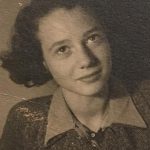 Just imagine living in a place where owning or even borrowing a book could get you, and anyone who gave you a book, killed. During the Holocaust, the Jews and other nationalities and religious groups who didn’t fit in with the Aryan race, were considered non-people, and therefore expendable. They were not allowed to live like normal people. They were considered “expendable.” Their lives were not worth the trouble it took to care for them, even their fiends and neighbors were expected to turn them over to be deported to the ghettos and even killed. They were often powerless to help themselves. Still, most of them never lost hope. When the Nazis began to occupy Czechoslovakia in 1939, the persecution of the Jews began almost immediately. Things were hard for everyone, but the children were often in more peril than anyone else. Many were to young to work and that made them even less “important” to the Nazis. To make matters worse, they were often separated from their parents…everything they knew was stripped from them.
Just imagine living in a place where owning or even borrowing a book could get you, and anyone who gave you a book, killed. During the Holocaust, the Jews and other nationalities and religious groups who didn’t fit in with the Aryan race, were considered non-people, and therefore expendable. They were not allowed to live like normal people. They were considered “expendable.” Their lives were not worth the trouble it took to care for them, even their fiends and neighbors were expected to turn them over to be deported to the ghettos and even killed. They were often powerless to help themselves. Still, most of them never lost hope. When the Nazis began to occupy Czechoslovakia in 1939, the persecution of the Jews began almost immediately. Things were hard for everyone, but the children were often in more peril than anyone else. Many were to young to work and that made them even less “important” to the Nazis. To make matters worse, they were often separated from their parents…everything they knew was stripped from them.
In 1942, when a girl named Dita Polachova was 13 years old, she and her parents were deported to Ghetto Theresienstadt life got even worse than it was before. Later they were sent to Auschwitz, where Dita’s father died. She and her mother were sent to forced labor in Germany and finally to a concentration camp called Bergen-Belsen. Dita’s mother died at Bergen-Belsen. Even in the face of so much sadness in her life, Dita never gave up. She risked her own life to protect a selection of eight books smuggled in by prisoners of Auschwitz. She stored the books in hidden pockets in her smock, and circulated them to the hundreds of children imprisoned in Block 31. Books were forbidden for the prisoners in the camps. The Nazis didn’t want them to have any knowledge of the outside world, or access to any kind of education materials or any books. The Nazis believed that none of these people were going to survive their stay in the camps anyway, so they didn’t need to do anything but work and die.
The prisoners had different ideas. Within the walls, there was a family camp known as BIIb. It was a place where the children could play and sing, but school was prohibited. Nevertheless, the Nazis were not able to enforce their will on the people. In spite of the orders of the Nazis, Fredy Hirsch established a small, yet influential school to house the children while their parents slaved in the camp. The materials were the biggest problem. The books, had to be hidden from the Nazi guards at all costs. Hirsch selected Dita, a brave and independent young woman from Prague to take over as the new Librarian of Auschwitz in January of 1944. Dita was a brave girl, who took her responsibility seriously.
While her parents are trying to stay alive in Auschwitz, Dita was fighting her own battle to preserve the books that bring joy to the children in the camp. The books are one of the few things that allow the children to escape from the walls in which they are surrounded, even if just for a moment. As the war progresses, Dita continues to diligently serve the teachers and children of Block 31. Then, Dita’s situation grew much worse. Her father passed away in the camp due to pneumonia. Dita and her mother are left alone to fight the battle on their own. Dita’s mother is grew weaker with age, and Dita knew she had to assume more responsibility. Dita is aware of the fact that the camp is simply a front to produce Nazi propaganda. She began to fight despair, as she struggles to feel the value in her life. By March 1944, the feeling of hopelessness grows. The Nazis announce that the inmates who arrived in September will be transferred to another division, which is really code for  murder. The BIIb continued until they heard that the Nazis are going to liquidate the family camp and separate the fit to work from the rest. Dita’s mother Liesl, was grown old and very weak by now. She was able to sneak into the group that is fit to work along with her daughter, narrowly. They were sent to the Bergen-Belsen concentration camp. Just when Dita gets to the point where she feels this might be the end, the Allied forces liberate the camp, but it is too late for Dita’s mother, who died just after the English arrived. Dita is now free, but it has been at great cost…the kind most of us cannot begin to comprehend. Dita later met and married Otto Kraus, an author, and they settled in Israel where they were both teachers.
murder. The BIIb continued until they heard that the Nazis are going to liquidate the family camp and separate the fit to work from the rest. Dita’s mother Liesl, was grown old and very weak by now. She was able to sneak into the group that is fit to work along with her daughter, narrowly. They were sent to the Bergen-Belsen concentration camp. Just when Dita gets to the point where she feels this might be the end, the Allied forces liberate the camp, but it is too late for Dita’s mother, who died just after the English arrived. Dita is now free, but it has been at great cost…the kind most of us cannot begin to comprehend. Dita later met and married Otto Kraus, an author, and they settled in Israel where they were both teachers.
 One of the criminal acts of Hitler and the Third Reich was to confiscate the riches of the countries they were occupying. It was not the worst of the atrocities, but it was up there. By confiscating the food and money of these countries, the Nazis left the people in those countries broke and starving. Even as the Third Reich began to know they were losing the war, there was hope that they would go into hiding, re-group, and rise again. If that was going to happen, they were going to need money, and the only way to insure that was to begin mass confiscation and hiding of the riches of these nations.
One of the criminal acts of Hitler and the Third Reich was to confiscate the riches of the countries they were occupying. It was not the worst of the atrocities, but it was up there. By confiscating the food and money of these countries, the Nazis left the people in those countries broke and starving. Even as the Third Reich began to know they were losing the war, there was hope that they would go into hiding, re-group, and rise again. If that was going to happen, they were going to need money, and the only way to insure that was to begin mass confiscation and hiding of the riches of these nations.
Lake Toplitz was located in a very remote area of Austria, southeast of Salzburg. In modern day Austria, the area is appropriately called The Dead Mountains. Basically, if you’re looking for somewhere to get away from it all, Lake Toplitz is a good choice. During the war, the lake’s remoteness made it the perfect place for the Nazis to test weapons…including torpedoes. It was also one of the places the Nazi elite fled to when it came time to make their last stand. That fact, in and of itself, makes it a logical place to hide funds for a future comeback of the Third Reich.
In 1945, Hitler’s Germany had only a few more weeks before their horrific reign ended, found themselves stuck in the middle, being crushed by the Russian tanks coming in from the east, and the Americans and British from the north. As their fronts collapsed, the Nazis made several efforts to hide their stolen wealth and treasure. The practice of hiding the wealth is well known, because a lot of that hidden wealth has already been discovered in mines, underground bunkers, and hastily buried fortifications.
Everyone seemed to be looking for the buried treasure left by the Nazis. At one time, a pair of treasure hunters announced they found the location of a buried German armored train in the hills of Poland. Their claim seemed 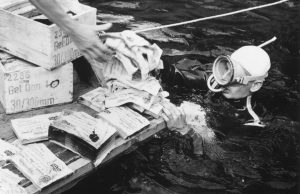 possible, so a search was held. In the end, it was determined that the “train” was nothing more than an ice covered rock formation. Still, the possibility of a treasure train is very real. Unfortunately, the big news about the “train” caused such a stir that another find was all but lost to the world.
possible, so a search was held. In the end, it was determined that the “train” was nothing more than an ice covered rock formation. Still, the possibility of a treasure train is very real. Unfortunately, the big news about the “train” caused such a stir that another find was all but lost to the world.
There had been stories about plunder the Nazis may have hidden in the cold, deep waters of Lake Toplitz, as the Allies closed in. Reports came out that the lake held iron boxes full of counterfeit British currency and the printing plates to make more…a part of Hitler’s Operation Bernhard, which was a plan to wreck the British economy by flooding the world with fake bank notes. That report turned out to be true, when dive crews recovered several chests stuffed with counterfeit cash in 1959. The divers reported there were more chests stuck in the mud, but they were too deep to recover. More stories about Nazi plunder at the bottom of Lake Toplitz surfaced. The nephew of one German officer made the claim that the Nazis sank chests loaded with gold into the lake. Plates from the lost fabled Russian Imperial Amber Room, which had also been rumored to be on the Nazi gold train in Poland, are also thought by others to be on the bottom of the icy lake. Along with treasure there are stories of weapons components, ammunition, rocket fuel, and maps showing the locations of even more stolen Nazi loot.
There have been many attempts to salvage treasure from the bottom of the lake over the years, with most of them ending in death. The lake is deep and cold, and has many tangled trees and branches that can trap a person. In 1983 the Austrian government declared the lake had been completely searched and anything of value removed. That turned out to be a fake story designed to discourage treasure hunters. Biologists studying the lake have turned up more boxes of counterfeit currency, rocket parts, weapons, mines and even a torpedo 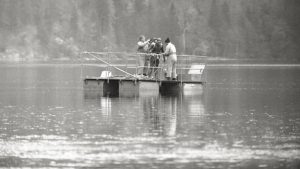 since the government report. Later, photographs from a submerged bunker surfaced, showing boxes with Cyrillic lettering. These are what led to the speculation that the boxes might contain panels from the Amber Room. The exact location of the bunker has been hidden from the public.
since the government report. Later, photographs from a submerged bunker surfaced, showing boxes with Cyrillic lettering. These are what led to the speculation that the boxes might contain panels from the Amber Room. The exact location of the bunker has been hidden from the public.
I expect that people will continue to try to find the treasures, even though claims will most likely be laid upon them immediately after they are located. The people who find them will probably only get the recognition for the find, rather than the right to keep the treasure. Maybe with an attorney who is good enough, they will walk away with a finders fee.
 My niece, Jenny Spethman has had a normal, average life by most standards. She has been a stay-at-home mom for much of her marriage, and has just recently started a part-time job at a law firm here in Casper, where she is a runner for the attorneys and legal staff there. This is an exciting time for Jenny. As any stay-at-home mom knows, being around kids for hours and hours every day, can bring a parent to the point of just wanting another adult to talk to. It wasn’t about the money really, although that comes in handy too. It was about doing something useful now that her children are in school…something new and interesting. I think that her new job is perfect for her, because there are so many new things to do, interesting people to be around, and legal procedures to learn.
My niece, Jenny Spethman has had a normal, average life by most standards. She has been a stay-at-home mom for much of her marriage, and has just recently started a part-time job at a law firm here in Casper, where she is a runner for the attorneys and legal staff there. This is an exciting time for Jenny. As any stay-at-home mom knows, being around kids for hours and hours every day, can bring a parent to the point of just wanting another adult to talk to. It wasn’t about the money really, although that comes in handy too. It was about doing something useful now that her children are in school…something new and interesting. I think that her new job is perfect for her, because there are so many new things to do, interesting people to be around, and legal procedures to learn.
Jenny’s exciting new job is something to celebrate, but there is so much more to Jenny. She is one of the strongest people I know. Jenny’s life hasn’t been perfect. She and her husband, Steve lost their daughter, Laila in 2010, and then gathered their strength and tried again, having their 5th child, Aleesia just 9 months later. After having three sons, they had wanted a daughter, and that made Laila’s passing more devastating. Nevertheless, they now have their rainbow baby in the form of daughter, Aleesia. Having another child after loss is a show of strength in  itself, but that is not the only way that Jenny’s inner strength presents itself.
itself, but that is not the only way that Jenny’s inner strength presents itself.
Jenny is a strong student of the Bible. She listens to God’s leading and receives revelations knowledge on so many matters of importance. Jenny is an early-riser, and loves to spend the early morning hours in Bible reading and Christian meditation on the Word. Her focus gives her strength on a daily basis. Jenny and Steve are united in their faith, and have learned to lean on God in all situations. Even with all they have gone through, it is often Jenny who is there to lift up others who are struggling, grieving, or just unsure what to do. We are all very proud of her strong, supportive ways, and we all count on her often. Today is Jenny’s birthday. Happy birthday Jenny!! Have a great day!! We love you!!
 When we think of war heroes, civilians seldom come to mind. The reality is that there are many, many civilian heroes in any war. Each of those civilian heroes has their own reasons to take the actions they take. The one similarity is that most of them simply cannot continue to support a government that is committing the atrocities they commit, and so they have to take action, or they can’t look themselves in the mirror again. Sometimes, a change of heart comes because they see the cruelty of the country they live in. Other times, the change comes when they see that their countrymen are not even safe from their own government. Finally, completely disillusioned, they find themselves without alternative options, when they come face to face with the enemy within their own boarders.
When we think of war heroes, civilians seldom come to mind. The reality is that there are many, many civilian heroes in any war. Each of those civilian heroes has their own reasons to take the actions they take. The one similarity is that most of them simply cannot continue to support a government that is committing the atrocities they commit, and so they have to take action, or they can’t look themselves in the mirror again. Sometimes, a change of heart comes because they see the cruelty of the country they live in. Other times, the change comes when they see that their countrymen are not even safe from their own government. Finally, completely disillusioned, they find themselves without alternative options, when they come face to face with the enemy within their own boarders.
Matvey Kuzmich Kuzmin was born on August 3, 1858 in the village of Kurakino, in the Velikoluksky District of Pskov Oblast. He was a self-employed farmer who declined the offer to join a kolkhoz or collective farm. He lived with his grandson and continued to hunt and fish on the territory of the kolkhoz “Rassvet” (Dawn). He was nicknamed “Biriuk” (lone wolf).
During World War II, the area Kuzmin lived in was occupied by the forces of Nazi Germany. In February 1942, Kuzmin had to help house a German battalion in the village of Kurakino. The German unit was ordered to pierce the Soviet defense in the area of Velikiye Luki by advancing into the rear of the Soviet troops dug in at Malkino Heights. Kuzmin had to do what he had to do…like it or not. On February 13, 1942, the German commander asked the 83 year old Kuzmin to guide his men to the Malkino Heights area, and even offered Kuzmin money, flour, kerosene, and a “Three Rings” hunting rifle for doing so. Kuzmin agreed, but he knew that with information on the proposed route, he could make a difference. He sent his grandson Vasilij to Pershino, about 3.5 miles from Kurakino, to warn the Soviet troops and to propose an ambush near the village of Malkino.
The plan was for Kuzmin to guide the German units through straining paths, through the night. He lead them to  the outskirts of Malkino at dawn. When they arrived, the village defenders and the 2nd battalion of 31st Cadet Rifle Brigade of the Kalinin Front attacked. The German battalion came under heavy machine gun fire and suffered losses of about 50 killed and 20 captured. In the midst of the ambush, a German officer realized that they had been set up and turned his pistol towards Kuzmin. He shot him twice. Kuzmin died during the fight. He was buried three days later with military honors. Later, he was reburied at the military cemetery of Velikiye Luki. He was posthumously named a Hero of the Soviet Union on May 8, 1965, becoming the oldest person named a Hero of the Soviet Union based on his age at death.
the outskirts of Malkino at dawn. When they arrived, the village defenders and the 2nd battalion of 31st Cadet Rifle Brigade of the Kalinin Front attacked. The German battalion came under heavy machine gun fire and suffered losses of about 50 killed and 20 captured. In the midst of the ambush, a German officer realized that they had been set up and turned his pistol towards Kuzmin. He shot him twice. Kuzmin died during the fight. He was buried three days later with military honors. Later, he was reburied at the military cemetery of Velikiye Luki. He was posthumously named a Hero of the Soviet Union on May 8, 1965, becoming the oldest person named a Hero of the Soviet Union based on his age at death.
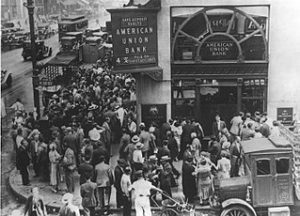 When we think of a bank, we expect that they will have an unlimited amount of money to cover any withdrawals the public might care to make. That thought really isn’t accurate at all. Banks typically hold only a fraction of deposits in cash at any one time, and lend out the rest to borrowers or purchase interest-bearing assets like government securities. As normal banking procedures occur, the money placed in bank care by depositors is loaned out to other people, but then replaced plus interest. The cash flow in the bank normally rolls merrily along in deposits, withdrawals, loans, and payments…as long as nothing goes wrong that is.
When we think of a bank, we expect that they will have an unlimited amount of money to cover any withdrawals the public might care to make. That thought really isn’t accurate at all. Banks typically hold only a fraction of deposits in cash at any one time, and lend out the rest to borrowers or purchase interest-bearing assets like government securities. As normal banking procedures occur, the money placed in bank care by depositors is loaned out to other people, but then replaced plus interest. The cash flow in the bank normally rolls merrily along in deposits, withdrawals, loans, and payments…as long as nothing goes wrong that is.
The stock market crash of October 1929 left the American public in a panic, about the economy, the future, and the stability of the banks. People were spending less and so the investments and loans began to decrease, which lead to a decline in production and employment. The ensuing snowball effect was further compounded when the nation’s economic woes led to a series of banking panics or “bank runs,” during which large numbers of anxious people withdrew their deposits in cash, forcing banks to liquidate loans, and ultimately leading to bank failure. The largest collapse was New York’s Bank of the United States in December 1931. The bank had more than $200 million in deposits at the time, making it the largest single bank failure in American history. Wealthy people began pulling their investment assets out of the economy. Bankruptcies were becoming more common, and peoples’ confidence in financial institutions, such as banks, rapidly eroded. Many of those people never fully trusted banks again after that. Some 650 banks failed in 1929, and the number rose to more than 1,300 the following year.
The last wave of bank runs continued through the winter of 1932 and into 1933. By that time, Democrat Franklin D. Roosevelt had won the presidential election over the Republican incumbent, Herbert Hoover. Almost immediately after taking office in early March, Roosevelt declared a national “bank holiday.” All banks were closed until they were determined to be solvent through federal inspection. Roosevelt called on Congress to come up with new emergency banking legislation to further aid the ailing financial institutions of America. The Banking Act of 1933 established the FDIC, or Federal Deposit Insurance Corporation. It also separated commercial and investment banking, and for the first time extended federal oversight to all commercial banks. The FDIC would insure commercial bank deposits of $2,500 (later $5,000) with a pool of money collected from the banks. Small, rural banks were in favor of deposit insurance, but larger banks, who worried they would end up subsidizing smaller banks, opposed it. The public supported deposit insurance overwhelmingly. Many hoped to recover some of the financial losses they had sustained through bank failures and closures. The FDIC did not insure investment products such as stocks, bonds, mutual funds or annuities. No federal law mandated FDIC insurance for banks, though some states required their banks to be federally insured.
In 2007, problems in the subprime mortgage market precipitated the worst financial crisis since the Great Depression. Twenty-five US banks had failed by late 2008. The most notable bankruptcy was Washington  Mutual Bank, the nation’s largest savings and loan association. A downgrade in the bank’s financial strength in September 2008 caused customers to panic despite Washington Mutual’s status as an FDIC-insured bank. Depositors withdrew $16.7 billion from Washington Mutual Bank over the next nine days. The FDIC subsequently stripped Washington Mutual of its banking subsidiary. It was the largest bank failure in US history. Congress passed the Dodd-Frank Wall Street Reform and Consumer Protection Act in 2011, which permanently raised the FDIC deposit insurance limit to $250,000 per account. The Dodd-Frank Act expanded the FDIC’s responsibilities to include regular risk assessments of all FDIC-insured institutions.
Mutual Bank, the nation’s largest savings and loan association. A downgrade in the bank’s financial strength in September 2008 caused customers to panic despite Washington Mutual’s status as an FDIC-insured bank. Depositors withdrew $16.7 billion from Washington Mutual Bank over the next nine days. The FDIC subsequently stripped Washington Mutual of its banking subsidiary. It was the largest bank failure in US history. Congress passed the Dodd-Frank Wall Street Reform and Consumer Protection Act in 2011, which permanently raised the FDIC deposit insurance limit to $250,000 per account. The Dodd-Frank Act expanded the FDIC’s responsibilities to include regular risk assessments of all FDIC-insured institutions.

 My nephew, Dave Chase, joined our family when he married my niece, Toni. Dave has a dry sense of humor, and is quite practical, which is completely opposite of Toni, who is more emotional, than practical…according to her mom, Cheryl. Dave and Toni love to banter back and forth, and it keeps the whole family laughing. They tease each other, and it can be quite entertaining. Still, it is teasing, and these two really bring out the best in each other.
My nephew, Dave Chase, joined our family when he married my niece, Toni. Dave has a dry sense of humor, and is quite practical, which is completely opposite of Toni, who is more emotional, than practical…according to her mom, Cheryl. Dave and Toni love to banter back and forth, and it keeps the whole family laughing. They tease each other, and it can be quite entertaining. Still, it is teasing, and these two really bring out the best in each other.
When Toni and Dave met, Dave did not try to become a father to her son James, who has a dad. Wisely, Dave set out to become James’ friend. He won James over, and they are good friends. That has endeared Dave to the whole family! Dave also loves having 2 child pups. He loves taking them to the dog park in good weather especially, but they go no matter what the weather looks like…rain, shine, wind, or snow. If they can get to the dog park, Dave and the pups are going for a walk. Twice on the weekend days. Toni joins them on weekends. The whole family loves their dogs. The dogs must have the best of everything, including toys, beds, comfort, and…a maze in snowy weather to exercise and entertain themselves in! He loves to take the dogs kayaking too. No effort is to great to be undertaken for the sake of the dogs!
Dave has always been full of energy. My niece tells me that he hits the ground running the second his feet move from the bed to the floor. Dave hasn’t always loved the length and cold of the Wyoming winter, but he got a snow blower, and he loves to keep his driveway clear. Needless to say, when Dave awoke to some six to ten inches of snow on his birthday morning, he was excited and headed out to “play” with his machine…never mind  that it’s still coming down heavily. While his snow blower has helped with his winter blues, he has managed to find another release in the form of an annual golfing trip to Phoenix with the boys. It is a trip that he plans every year and brags that “the head count keeps on growing.” While Dave is there he always heads to Chase field to catch a game with his little brother Dan and nephew Ty, always in the hope of seeing the Dodgers, but this last April 2019 he had to settle for the Cubs.
that it’s still coming down heavily. While his snow blower has helped with his winter blues, he has managed to find another release in the form of an annual golfing trip to Phoenix with the boys. It is a trip that he plans every year and brags that “the head count keeps on growing.” While Dave is there he always heads to Chase field to catch a game with his little brother Dan and nephew Ty, always in the hope of seeing the Dodgers, but this last April 2019 he had to settle for the Cubs.
Dave and Toni took a trip…just the two of them, to Marco Island where they hit a different brewery every day, ate seafood every night, and had a great time all week including their last day there when they took a trip to Venice Beach. They learned how to shell for shark teeth at Venice Beach. They also “learned” how to lock their water, sunblock, beach towels and cell phones in the car while at Venice Beach, as well as how to lose their car keys in the ocean while at Venice Beach, and…they learned how to thank God for putting a little boy in the water that found their keys…30 yards from where they were looking for them.
They took a family trip to Escondido California, James got to go on this trip too. They all agreed that it was one of the best trips they have ever had. It exceeded all of their expectations. They went to the Miramar Air show, which made them feel very proud to be Americans, and to Cabrillo National Monument to name a few. Other than that trip, they took numerous overnight trips, saw a few concerts, watched the dodgers play, and of course, Dave made it to every home game for the Wyoming Cowboys.
Dave is good to his mother-in-law, Cheryl too. In winter, if the snow gets bad, Dave checks with her to see if anyone has shoveled her walk and if they haven’t, he will drive all the way across town to shovel for her! In the 
 spring and fall he, along with the rest of her family, cleans her yard so it’s ready for the coming season. These are kindnesses she appreciates so much more than words can say! Of course, mostly Cheryl loves that he takes care of Toni. He has always seen to it she has a good car to drive, a lovely home to live in, and that all her needs and wants are met. He’s practical and good in his heart! He considers what is needed in the family, and helps bring those things to pass. To Cheryl, these are excellent qualities! I agree. Today is Dave’s birthday. Happy birthday Dave!! Have a great day!! We love you!!
spring and fall he, along with the rest of her family, cleans her yard so it’s ready for the coming season. These are kindnesses she appreciates so much more than words can say! Of course, mostly Cheryl loves that he takes care of Toni. He has always seen to it she has a good car to drive, a lovely home to live in, and that all her needs and wants are met. He’s practical and good in his heart! He considers what is needed in the family, and helps bring those things to pass. To Cheryl, these are excellent qualities! I agree. Today is Dave’s birthday. Happy birthday Dave!! Have a great day!! We love you!!
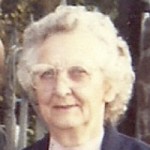
 My husband’s grandmother, Vina Hein was a remarkable woman. I was quite impressed with her work ethic. That might seem a funny thing to say about a woman who no longer worked outside the home, but she was, nevertheless, dedicated to he work…her home. For most of her life, she lived as a pioneer woman, because while her home had many things, and was a normal stick built home, it did not have an indoor bathroom, even though the bathroom was somewhat completed. Water was the main concern, as well water was used, and there is always the concern of a well running dry, I suppose.
My husband’s grandmother, Vina Hein was a remarkable woman. I was quite impressed with her work ethic. That might seem a funny thing to say about a woman who no longer worked outside the home, but she was, nevertheless, dedicated to he work…her home. For most of her life, she lived as a pioneer woman, because while her home had many things, and was a normal stick built home, it did not have an indoor bathroom, even though the bathroom was somewhat completed. Water was the main concern, as well water was used, and there is always the concern of a well running dry, I suppose.
Grandma was born on Groundhog Day, February 2, 1909. Of course, we all know that the ground hog has a 50-50 chance of guessing right concerning winter, and I personally think that the latest Punxsutawney Phil, maybe doesn’t have its act together. Todays prediction was for an early spring, but…time will tell. According to statistics, the groundhog saw its shadow in 1909, so that should have been six more weeks of winter. I have no idea what the winter ended up like in Montana, but knowing what Montana winters are usually like, In would be surprised if the winter ended early.
Grandma Hein saw many changes over the years of her life. From the early days of automobiles and airplanes 
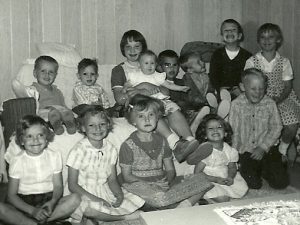 to the more modern days of both before her passing. She saw telephones, and even the early days of cell phones. She was able to travel to the places where her children moved, and meet grandchildren, great grandchildren, and even 2nd great grandchildren. She lived a long and happy life, and yet we still never felt like she was with us long enough. Today, Grandma would have been 111 years old, but that would have been an unlikely birthday to have happened. Nevertheless, happy birthday in Heaven, Grandma Hein. We love and miss you very much.
to the more modern days of both before her passing. She saw telephones, and even the early days of cell phones. She was able to travel to the places where her children moved, and meet grandchildren, great grandchildren, and even 2nd great grandchildren. She lived a long and happy life, and yet we still never felt like she was with us long enough. Today, Grandma would have been 111 years old, but that would have been an unlikely birthday to have happened. Nevertheless, happy birthday in Heaven, Grandma Hein. We love and miss you very much.

